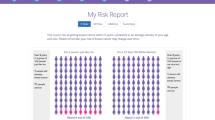Abstract
The Dana-Farber Harvard Cancer Center and the Harvard Center for Cancer Prevention convened a conference in May 2002 to review the current issues in breast cancer risk communication and to identify directions for future research. Specific topics included risk communication theory, use of risk models in breast cancer screening, genetic testing, decision-making regarding breast cancer treatment, and the role of popular media in risk communication. This report describes the proceedings of the conference.
Similar content being viewed by others
References
Jemal A,Thomas A,Murray T, et al. (2002) Cancer statistics, 2002. CA Cancer J Clin 52: 23-47.
Ovretveit J (1996) Informed choice? Health service quality and outcome information for patients. Health Policy 37: 75-90.
Neuberger J (2000) The educated patient: new challenges for the medical profession. J Intern Med 247: 6-10.
Fischhoff B,Bostrom A,Quadrel MJ (2000) Risk perception and communication. In: Detels R,McEwen R,Beaglehole R,Tanaka H, eds. Oxford Textbook of Public Health, London: Oxford University Press, pp. 987-1002.
Fischhoff B (1999) Why (cancer) risk communication can be hard. Monogr J Natl Cancer Inst 25: 7-13.
National Institutes of Health Consensus Development Panel(1997) NIH Consensus Conference Statement: Breast cancer screening for women 40-49. Monogr J Natl Cancer Inst 22: vii-xviii.
Gail MH,Brinton LA,Byar DP, et al. (1989) Projecting individualized probabilities of developing breast cancer for white females who are being examined annually. J Natl Cancer Inst 81: 1879-1996.
Claus EB,Risch N,Thompson WD (1994) Autosomal dominant inheritance of early-onset breast cancer. Implications for risk prediction. Cancer 73: 643-651.
Couch FJ,DeShano ML,Blackwood MA, et al. (1997) BRCA1 mutations in women attending clinics that evaluate the risk of breast cancer. N Engl J Med 336: 1409-1415.
Shattuck-Eidens D,McClure M,Simard J, et al. (1995) A collaborative survey of 80 mutations in the BRCA1 breast and ovarian cancer susceptibility gene: implications of presymptomatic testing and screening. JAMA 273: 535-541.
Frank TS,Manley SA,Olopade OI, et al. (1998) Sequence analysis of BRCA1 and BRCA2: correlation of mutations with family history and ovarian cancer risk. J Clin Oncol 16: 2417-2425.
Berry DA,Iversen ES,Gudbjartsson DF, et al. (2002) BRCAPRO validation, sensitivity of genetic testing of BRCA1/BRCA2, and prevalence of other breast cancer susceptibility genes. J Clin Oncol 20: 2701-2712.
Breast Cancer Risk Assessment Tool. http://brca.nci.nih.gov/brc.
Rockhill B,Spiegelman D,Byrne C,Hunter DJ,Colditz GA (2001) Validation of the Gail et al. model of breast cancer risk prediction and implications for chemoprevention. J Natl Cancer Inst 93: 358-366.
Edwards A,Elwyn G,Mulley A (2002) Explaining risks: turning numerical data into meaningful pictures. BMJ 324: 827-830.
Couch FJ,DeShano ML,Blackwood MA, et al. (1997) BRCA1 mutations in women attending clinics that evaluate the risk of breast cancer. N Engl J Med 336: 1409-1415.
Berry DA,Parmigiani G,Sanchez J,Schildkraut J,Winer E (1997) Probability of carrying a mutation of breast-ovarian gene BRCA1 based on family history. J Natl Cancer Inst 89: 227-238.
Bluman LG,Rimer BK,Berry DA, et al. (1999) Attitudes, knowledge, and risk perceptions of women with breast and/or ovarian cancer considering testing for BRCA1 and BRCA2. J Clin Oncol 17: 1040-1046.
Dorval M,Patenaude AF,Schneider KA, et al. (2000) Anticipated versus actual emotional reactions to disclosure of results of genetic tests for cancer susceptibility: findings from p53 and BRCA1 programs. J Clin Oncol 18: 2135-2142.
Lerman C,Hughes C,Lemon SJ, et al. (1998) What you don't know can hurt you: adverse psychologic effects in members of BRCA1-linked and BRCA-2 linked families who decline genetic testing. J Clin Oncol 16: 1650-1654.
Lerman C,Hughes C,Croyle RT, et al. (2000) Prophylactic surgery decisions and surveillance practices one year following BRCA1/2 testing. Prev Med 31: 75-80.
Degner LF,Kristjanson LJ,Bowman D, et al. (1997) Information needs and decisional preferences in women with breast cancer. JAMA 277: 1485-1492.
Ravdin PM,Siminoff IA,Harvey JA (1998) Survey of breast cancer patients concerning their knowledge and expectations of adjuvant therapy. J Clin Oncol 16: 515-521.
Bluman LG,Borstelmann NA,Rimer BK, et al. (2001) Knowledge, satisfaction, and perceived cancer risk among women diagnosed with ductal carcinoma in situ. J Women Health Gend Based Med 10: 589-598.
O'Connor AM,Fiset V,DeGrasse C, et al. (1999) Decision aids for patients considering options affecting cancer outcomes: evidence of efficacy and policy implications. J Natl Cancer Inst Monogr 25: 67-80.
Levine MN,Gafni A,Markham B,MacFarlane D (1992) A bedside decision instrument to elicit a patient's preference concerning adjuvant chemotherapy for breast cancer. Ann Intern Med 117: 53-58.
Whelan TJ,Levine MN,Gafni A, et al. (1995) Breast irradiation postlumpectomy: development and evaluation of a decision instrument. J Clin Oncol 13: 847-853.
Goel V,Sawka CA,Thiel EC,Gort EH,O'Connor AM (2001) Randomized trial of a patient decision aid for choice of surgical treatment for breast cancer. Med Decis Making 21: 1-6.
Ravdin PM,Siminoff LA,Davis GJ, et al. (2001) Computer program to assist in making decisions about adjuvant therapy for women with early breast cancer. J Clin Oncol 19: 980-991.
Author information
Authors and Affiliations
Corresponding author
Rights and permissions
About this article
Cite this article
Nekhlyudov, L., Partridge, A. Breast cancer risk communication: challenges and future research directions: workshop report (United States). Cancer Causes Control 14, 235–239 (2003). https://doi.org/10.1023/A:1023684230438
Issue Date:
DOI: https://doi.org/10.1023/A:1023684230438



